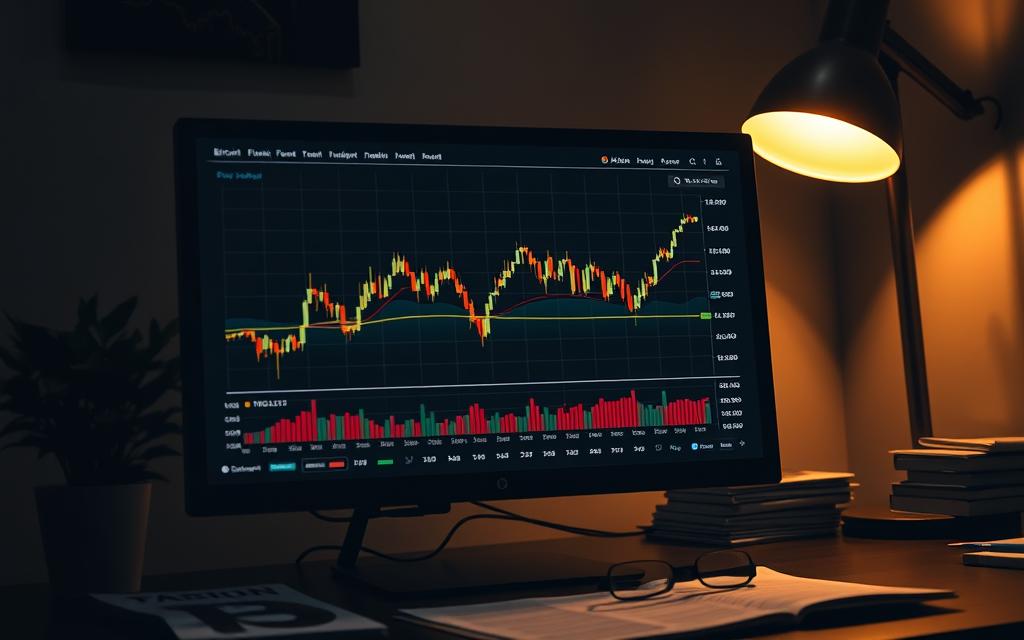Table of Contents
The cryptocurrency market is known for its volatility, and Bitcoin is no exception. After significant price corrections, investors are left wondering about the future of this digital asset.
As we examine Bitcoin’s historical performance, it’s clear that its value has fluctuated greatly, from cents to tens of thousands of dollars. The 2022 crash raised concerns, but expert analysis suggests that various factors, including institutional investment and macroeconomic conditions, could influence its future price trajectory.
Our analysis will provide insights into the potential impact of the upcoming 2024 Bitcoin halving event and expert price predictions for the short-term and long-term horizons.
Current State of Bitcoin: Price Performance and Market Position
As the leading cryptocurrency, Bitcoin’s price performance is under intense scrutiny. According to the latest data, Bitcoin is currently trading around $108,127 USD.
The market sentiment is a crucial factor in understanding Bitcoin’s current state. Technical indicators signal about a neutral to Bullish 67% market sentiment, while the Fear & Greed Index is displaying a score of 68, indicating “Greed” in the market.
Over the last 30 days, Bitcoin has had 17/30 (57%) green days and 1.72% price volatility. This moderate volatility with a positive bias is a significant factor in its current trading range.
Bitcoin’s market dominance remains strong as the number one cryptocurrency by market capitalization. Its performance often sets the tone for the broader crypto market.
| Indicator | Value |
|---|---|
| Current Price | $108,127 |
| Market Sentiment | 67% Bullish |
| Fear & Greed Index | 68 (Greed) |
| 30-day Volatility | 1.72% |
As noted by analysts, institutional interest continues to provide price support through ETF purchases. Major financial institutions like BlackRock are continuing their daily accumulation, creating a “floor effect” for Bitcoin’s price.
“The current price represents a significant recovery from the mid-November 2022 low of approximately $16,700, demonstrating Bitcoin’s resilience despite challenging market conditions.”
The current value of Bitcoin is a reflection of its complex market dynamics, influenced by both technical indicators and broader crypto market trends.
Bitcoin’s Historical Price Journey: From Cents to All-Time Highs
The history of Bitcoin’s price is a fascinating tale of rapid appreciation, from less than a penny to nearly $68,000 at its peak. Introduced to the financial market in 2009, Bitcoin’s first significant leap in price happened in July 2010, when it rose to $0.09.
Bitcoin’s price history represents one of the most remarkable asset appreciation stories in financial history. Key milestones include:
- The first recorded price of less than a penny, marking the beginning of its journey.
- The first significant price milestone in July 2010, reaching $0.09.
- A major bull run in 2013, surging from around $13 to over $1,100.
- The 2017 bull market, reaching an all-time high of nearly $20,000.
- A peak in November 2021, reaching approximately $68,000, representing a staggering 75,000,000% increase from its earliest recorded price.
Throughout its history, Bitcoin has demonstrated a cyclical pattern of dramatic surges followed by significant corrections.  Each cycle has generally reached higher peaks than the previous one, a pattern many analysts believe will continue.
Each cycle has generally reached higher peaks than the previous one, a pattern many analysts believe will continue.
The journey from cents to all-time highs is a testament to Bitcoin’s resilience and the growing interest in cryptocurrencies. As the pioneer of cryptocurrencies, Bitcoin’s value has been shaped by its early adoption, technological advancements, and market demand.
The 2022 Crash: Understanding Why Bitcoin Fell
A combination of macroeconomic pressures and crypto market-specific issues led to Bitcoin’s substantial price decrease in 2022. The global economy experienced a turbulent year, with high levels of inflation prompting the Federal Reserve to implement a series of aggressive interest rate hikes.
Higher interest rates make borrowing more expensive and reduce spending, which can lead to investors selling off their assets. This had a direct impact on Bitcoin’s price, causing it to decline significantly. Furthermore, the crypto market was riddled with bad press due to the collapse of the crypto exchange FTX, resulting in a loss of over $1 billion in consumer funds.
The crash was characterized by several key factors. Bitcoin experienced a dramatic 70% price decline from its November 2021 peak of $68,000 to around $16,700 by mid-November 2022. Macroeconomic pressure was a primary driver, as the Federal Reserve’s aggressive interest rate hikes made risk assets like Bitcoin less attractive to investors seeking yield from safer alternatives.
| Factor | Impact on Bitcoin’s Price |
|---|---|
| Macroeconomic Pressure | Reduced investor appetite for risk assets |
| Collapse of FTX | Loss of over $1 billion in consumer funds, damaging investor confidence |
| Geopolitical Tensions | Contributed to broader economic instability |
Despite the severe correction, Bitcoin’s value remained significantly higher than its pre-2020 levels, demonstrating that even after major drawdowns, the long-term price trajectory has historically remained upward. The crypto market’s resilience in the face of adversity is a testament to its growing maturity.
Will Bitcoin Go Back Up? Key Factors to Consider
The future of Bitcoin’s price is uncertain, but several key factors could influence its potential recovery. The crypto market is known for its volatility, and Bitcoin price movements are closely watched by investors worldwide.
Several variables could potentially lead to a rise in Bitcoin’s price. Lower interest rates could make riskier assets like Bitcoin more appealing to investors. The expected approval of the first spot Bitcoin ETF is another significant factor that could drive the price up. Additionally, a reduced threat of recession could positively impact Bitcoin’s price as investor risk appetite increases.

The potential for Bitcoin’s price recovery hinges on several interconnected factors. Monetary policy is a primary driver; a shift toward lower interest rates would likely increase investor appetite for higher-risk assets like Bitcoin. The anticipated approval of the first spot Bitcoin ETF represents a significant catalyst, providing easier access for institutional and retail investors to gain Bitcoin exposure through traditional investment vehicles.
- Macroeconomic stability, particularly a reduced threat of recession, would likely benefit Bitcoin’s price as investor risk appetite increases.
- The continued institutional adoption of Bitcoin as a treasury reserve asset could create sustained buying pressure.
- Bitcoin’s fixed supply cap of 21 million coins creates a scarcity dynamic that becomes increasingly relevant as adoption grows.
| Factor | Impact on Bitcoin Price |
|---|---|
| Lower Interest Rates | Increased investor appetite for riskier assets |
| Approval of First Spot Bitcoin ETF | Easier access for investors, potential price surge |
| Reduced Recession Threat | Increased investor risk appetite, positive price trend |
Technical analysis suggests that Bitcoin has formed a bull flag pattern targeting $158,000, indicating that the current consolidation phase may be setting up for another explosive move higher if key support levels hold. The broader acceptance of crypto as a legitimate asset class by traditional financial institutions continues to expand Bitcoin’s potential investor base.
In conclusion, the prediction for Bitcoin’s price is closely tied to various market and economic factors. Understanding these factors is crucial for investors looking to navigate the volatile crypto market.
The Role of Institutional Investors in Bitcoin’s Price Recovery
Institutional investors have become a dominant force in Bitcoin trading, influencing its market dynamics. Their involvement has brought about a significant shift in how Bitcoin is perceived and traded.
The crypto market benefits from growing institutional confidence, with major financial institutions like BlackRock continuing their daily accumulation through ETF purchases. This steady institutional demand creates a floor effect, preventing significant downside moves while supporting upward momentum.

Several key factors highlight the impact of institutional investors on Bitcoin:
- Institutional investors have emerged as a dominant force in the Bitcoin market, with their trading patterns and accumulation strategies often having outsized effects on BTC price movements.
- Major financial institutions have established consistent Bitcoin accumulation programs through ETF purchases, creating a “floor effect” that helps prevent significant downside price movements.
- Corporate treasury adoption of Bitcoin as a store value and inflation hedge continues to expand.
| Institution | Bitcoin Holdings | Approximate Value |
|---|---|---|
| MicroStrategy | 582,000 BTC | $63.85 billion |
| BlackRock | N/A | N/A |
The entrance of traditional financial giants into the crypto space has legitimized Bitcoin as an institutional-grade asset, dramatically expanding its potential investor base. As a result, trading volumes have increased, bringing greater liquidity and potentially reducing the extreme volatility that historically characterized the market.
Technical Analysis: Bitcoin’s Current Price Patterns and Indicators
Bitcoin’s current price patterns and indicators are showing promising signs for a potential uptrend. At the time of writing, Bitcoin is trading near $109,500, having experienced a minor correction of 0.7% after successfully defending the critical $110,000 support level during recent trading sessions.
A technical analysis of Bitcoin’s price action reveals a bull flag pattern targeting $158,000, suggesting that the current consolidation phase may be setting up for another explosive move higher if key support levels hold. The 50-day moving average is rising on multiple timeframes (4-hour, daily, and weekly charts), indicating strong momentum across short, medium, and long-term perspectives.
The key support levels have been established at $110,000 (immediate), $100,000 (psychological and technical, coinciding with the 50-day EMA), and $92,000-$90,000 (long-term, aligning with the 200-day moving average). Trading volumes have remained robust throughout the recent consolidation phase, suggesting healthy market participation and potential for continued upward movement if buying pressure persists.
| Support Level | Price | Description |
|---|---|---|
| Immediate | $110,000 | Critical support level |
| Psychological/Technical | $100,000 | Coincides with 50-day EMA |
| Long-term | $92,000-$90,000 | Aligns with 200-day moving average |
The recent price action shows that Bitcoin has exited a regression channel that had been forming over the past three weeks, potentially signaling the end of the consolidation phase and the beginning of a new uptrend. Technical indicators suggest that as long as Bitcoin maintains support above the $90,000-$92,000 zone, any pullbacks should be viewed as technical corrections and potential buying opportunities rather than the beginning of a bearish trend.
Based on the technical analysis, if Bitcoin manages to hold the $110,000 level, a retest of the all-time high from May 22 at $112,000 should only be a matter of time. The trading environment remains favorable, with robust volumes and strong momentum indicators supporting the potential for further price appreciation.
The Impact of Macroeconomic Factors on Bitcoin’s Price
The impending CPI release has investors on edge, as it may hold the key to Bitcoin’s short-term price direction. According to Dr. Kirill Kretov from CoinPanel, the CPI data represents “the main macro catalyst on everyone’s radar” for Bitcoin and Ethereum price action.
Macroeconomic factors have emerged as primary drivers of Bitcoin’s price movements. The Federal Reserve’s monetary policy decisions have particularly significant impacts on market sentiment and investor behavior. Inflation data, especially the Consumer Price Index (CPI), has become a critical catalyst for Bitcoin price action.

- Interest Rates: Interest rates directly influence Bitcoin’s attractiveness as an investment. Higher rates typically pressure prices downward as investors can achieve meaningful yields in lower-risk assets.
- Geopolitical Tensions: Conflicts like the Russia-Ukraine war create market uncertainty that can drive both risk-off sentiment (negative for Bitcoin) and increased demand for alternative assets outside traditional financial systems (potentially positive).
- Economic Growth Indicators: Stronger economic growth typically supports higher Bitcoin prices as investors become more willing to allocate capital to higher-risk, higher-reward assets.
- Currency Devaluation Concerns: Concerns about the US dollar’s value have historically benefited Bitcoin as investors seek alternative stores of value, viewing it as a hedge against monetary inflation.
- Global Liquidity Conditions: Central bank policies worldwide significantly impact capital flows into crypto markets. Expansionary policies generally support higher Bitcoin prices through increased available investment capital.
As the market continues to evolve, understanding these macroeconomic factors will be crucial for investors looking to navigate the complexities of the crypto space.
Bitcoin Halving: How the 2024 Event Could Influence Prices
The upcoming Bitcoin halving in 2024 is expected to have a profound effect on the cryptocurrency’s supply and demand dynamics. This event, which occurs approximately every four years, will reduce the reward for mining new blocks from 6.25 BTC to 3.125 BTC, effectively cutting the rate of new Bitcoin creation in half.
Historically, halving events have preceded significant price surges, with previous halvings in 2012, 2016, and 2020 all followed by bull markets that established new all-time highs. The halving mechanism is built into Bitcoin’s code, creating a predictable supply reduction that contrasts sharply with the inflationary nature of fiat currencies.
- The event will reduce Bitcoin’s inflation rate to approximately 0.9%, making it even scarcer than gold, potentially strengthening Bitcoin’s “digital gold” narrative.
- Market anticipation of the halving event often begins months in advance, with investors potentially accumulating Bitcoin in prediction of post-halving price increases based on historical patterns.
- The economic principle underlying the potential price impact is simple: if demand remains constant or increases while the rate of new supply is cut in half, price appreciation typically follows.
For more information on Bitcoin halving, you can visit Investopedia’s detailed guide on the topic. This resource provides a comprehensive overview of the halving mechanism and its historical impact on Bitcoin price.
While historical patterns suggest a positive price impact, the increasing maturity of the Bitcoin market and greater institutional participation may alter how the market responds to this event compared to previous cycles. As the event approaches, investors are watching closely for signs of a potential surge in BTC price.

Expert Price Predictions for Bitcoin in 2025
Experts are becoming more bullish on Bitcoin’s prospects, with predictions for 2025 indicating a potential surge in price. Leading analysts have shared their forecasts, with some being remarkably optimistic about Bitcoin’s trajectory through 2025.
Standard Chartered’s ambitious forecast projects Bitcoin reaching $200,000 by year-end 2025, representing an 82% surge from current levels. This prediction aligns with multiple institutional forecasts suggesting Bitcoin’s fair value could reach $230,000. Bitwise analysts have calculated Bitcoin’s “fair value” at approximately $230,000 based on quantitative models that factor in current sovereign default probabilities and Bitcoin’s increasing scarcity.

Technical analysis from multiple sources suggests Bitcoin’s bull flag pattern is targeting $158,000 in the near term, potentially setting the stage for moves toward the $200,000 level by 2025. According to the latest data gathered from cryptocurrency experts, the minimum BTC price in 2025 is expected to be around $100,265, with a maximum potential level of $136,927, representing significant upside from current prices.
| Prediction Source | 2025 Prediction |
|---|---|
| Standard Chartered | $200,000 |
| Bitwise Analysts | $230,000 |
| Cathie Wood’s Ark Invest | $1 million by 2030 |
Institutional forecasts have become increasingly bullish following the approval of spot Bitcoin ETFs, with the increased accessibility to Bitcoin investment expected to drive substantial new capital into the market over the next two years. Cathie Wood’s Ark Invest maintains one of the most aggressive Bitcoin price predictions, targeting $1 million within five years (by 2030), based on Bitcoin’s finite supply and growing adoption as a global store of value.
The consensus among experts is that 2025 will likely see Bitcoin establish new all-time highs, with the majority of price predictions falling in the $150,000-$250,000 range by year-end. As the cryptocurrency market continues to evolve, these predictions will be crucial in understanding Bitcoin’s potential trajectory.
Michael Saylor’s $1 Million Bitcoin Prediction: Analysis and Rationale
Michael Saylor’s prediction of Bitcoin reaching $1 million is grounded in his supply shock theory, which highlights the critical imbalance between supply and demand. As the Executive Chairman of MicroStrategy, Saylor has been a vocal advocate for Bitcoin, backing his assertions with substantial investments.
Saylor’s prediction isn’t based on speculation but on fundamental supply-demand mathematics. The core of his argument lies in the fact that only 450 new Bitcoin become available daily through mining, worth approximately $50 million at current prices. When institutional demand exceeds this threshold, “the price has got to move up,” according to Saylor’s analysis.
“Bitcoin is going to $1 million… It’s not a matter of if, but when,” Saylor has stated, emphasizing the inevitability of the price increase due to the supply-demand imbalance.
The key factors supporting Saylor’s prediction include:
- The limited supply of Bitcoin, capped at 21 million BTC, creates a scarcity that drives value.
- MicroStrategy’s massive 582,000 Bitcoin holdings demonstrate institutional conviction behind Saylor’s predictions.
- Growing institutional adoption and improved accounting standards have matured the Bitcoin market.
| Factor | Description | Impact on Price |
|---|---|---|
| Supply Limitation | Only 450 new BTC are mined daily | Increased scarcity drives price up |
| Institutional Adoption | Companies like MicroStrategy invest heavily in BTC | Increased demand drives price up |
| Market Maturity | Improved accounting and growing acceptance | Reduces risk, attracts more investors |

Saylor’s binary outcome perspective suggests that Bitcoin either goes to zero or reaches $1 million. Given Bitcoin’s survival through multiple market cycles and increasing institutional integration, the latter scenario is strongly supported.
In conclusion, Saylor’s $1 million Bitcoin prediction is based on robust fundamental analysis, emphasizing the impact of supply-demand dynamics and growing institutional adoption on Bitcoin’s price.
Long-Term Bitcoin Price Forecasts: 2026-2030
As we look ahead to the next five years, the long-term Bitcoin price forecasts for 2026-2030 reveal a promising trajectory. Analysts have been studying historical trends and current market conditions to predict future prices.
The forecast for 2026 suggests that the minimum price of Bitcoin will be around $180,705, with a maximum expected price of $226,512. On average, the trading price is anticipated to be $186,136. This represents a significant increase from current levels, with potential growth of over 100%.
Moving into 2027, cryptocurrency experts project that Bitcoin’s price range will expand to between $268,320 and $309,710, with an average trading value of approximately $275,766. This continuing upward momentum is supported by the growing adoption of Bitcoin and advancements in blockchain technology.
| Year | Minimum Price | Maximum Price | Average Trading Price |
|---|---|---|---|
| 2026 | $180,705 | $226,512 | $186,136 |
| 2027 | $268,320 | $309,710 | $275,766 |
| 2028 | $402,698 | $469,273 | $435,985 |
By 2028, the forecast becomes even more bullish, with technical analysis suggesting that Bitcoin could reach between $402,698 and $469,273. This potentially quadruples current values within just four years, driven by continued institutional investment and the programmed scarcity of Bitcoin due to the halving events.
As we approach 2030, the most optimistic projections align with Michael Saylor’s vision of Bitcoin reaching $1 million. Some models suggest that if current adoption trends continue and institutional investment accelerates, Bitcoin could indeed approach this milestone.

It’s essential to note that while these forecasts represent significant potential returns, analysts caution that the path will likely include substantial volatility, with multiple market cycles of expansion and contraction.
In conclusion, the long-term Bitcoin price forecasts for 2026-2030 indicate a consistent upward trajectory, driven by growing adoption, institutional investment, and the inherent scarcity of Bitcoin. As with any investment, it’s crucial to be aware of the potential risks and volatility.
Bitcoin’s Supply Dynamics: Scarcity as a Price Driver
Bitcoin’s value proposition is deeply rooted in its scarcity, a factor that significantly influences its price dynamics. The total supply of Bitcoin is capped at 21 million, creating a fundamental scarcity that distinguishes it from fiat currencies and other cryptocurrencies.
The Bitcoin halving events, occurring approximately every four years, systematically reduce the rate of new BTC entering circulation. The next halving event in 2024 will cut the daily new supply from 900 to 450 Bitcoin, further reducing the available BTC.

Currently, only about 450 new Bitcoin, worth approximately $50 million at current prices, become available daily through mining. This creates a supply shock when institutional demand exceeds this threshold, driving up the price. With approximately 19.88 million Bitcoin already mined, less than 1.2 million BTC remain to be created over the next 100+ years.
An estimated 3-4 million Bitcoin are considered permanently lost, further reducing the actual available supply. This scarcity, combined with growing institutional and retail adoption, creates a powerful economic dynamic that drives Bitcoin’s value appreciation over the long term.
| Event | Year | Daily Supply | Impact on Price |
|---|---|---|---|
| Halving Event | 2024 | 450 BTC | Potential Price Increase |
| Final Mining | 2140 | 0 BTC | Maximum Scarcity |
The combination of a fixed supply cap, regular halving events, and increasing adoption strengthens Bitcoin’s position as a store of value. As the price continues to be influenced by these dynamics, understanding Bitcoin’s supply dynamics is crucial for investors and analysts alike.
Regulatory Developments and Their Impact on Bitcoin’s Future
The impact of regulatory developments on Bitcoin’s future cannot be overstated, presenting both opportunities and challenges. Regulatory frameworks can significantly influence Bitcoin’s price and overall market value.
Recent regulatory milestones, such as the approval of spot Bitcoin ETFs in the United States, have marked significant steps in Bitcoin’s regulatory acceptance. This move provided traditional investors with regulated exposure to Bitcoin’s price movements without the need for direct ownership.
Global regulatory approaches to crypto remain fragmented. While some countries like El Salvador have adopted Bitcoin as legal tender, others have implemented various degrees of restriction or encouragement. The classification of Bitcoin by regulatory bodies has significant implications for its taxation, trading, and institutional adoption, ultimately affecting its price.
| Regulatory Aspect | Impact on Bitcoin |
|---|---|
| Clear Regulatory Frameworks | Encourage institutional adoption, potentially increasing value |
| Overly Restrictive Policies | Limit growth and reduce market confidence |
| AML and KYC Requirements | Reduce illicit activities, increase legitimacy in traditional finance |
In conclusion, regulatory developments will continue to play a crucial role in shaping Bitcoin’s price and market dynamics. As the regulatory landscape evolves, it is likely to have a lasting impact on the crypto market.
Risk Factors That Could Prevent Bitcoin’s Price Recovery
Despite optimistic forecasts, several risk factors could hinder Bitcoin’s price recovery. The cryptocurrency market is known for its volatility, and various factors can impact Bitcoin’s value.
Several significant risks could prevent Bitcoin from going back up to new all-time highs. Regulatory crackdowns remain a primary concern, as they could severely restrict Bitcoin’s adoption and utility. Moreover, technological vulnerabilities, although unlikely, represent a catastrophic risk scenario that could undermine confidence in the entire crypto market.
- Competition from central bank digital currencies (CBDCs) and other cryptocurrencies could dilute Bitcoin’s market dominance and value proposition.
- Macroeconomic deterioration, particularly a severe global recession, could trigger risk-off sentiment across all asset classes, potentially leading to significant Bitcoin price declines.
- Escalating geopolitical tensions or international conflicts could create unpredictable market conditions that might negatively impact Bitcoin’s price recovery.
| Risk Factor | Potential Impact |
|---|---|
| Regulatory Crackdowns | Restrict adoption and utility |
| Technological Vulnerabilities | Undermine confidence in crypto market |
| Macroeconomic Deterioration | Trigger risk-off sentiment |
Environmental concerns regarding Bitcoin’s energy consumption continue to attract criticism, with potential regulatory responses or corporate ESG policies limiting institutional adoption. Additionally, market manipulation remains a concern in the relatively small crypto market, with large holders (“whales”) capable of creating significant price volatility.
In conclusion, while Bitcoin has the potential to recover, these risk factors could prevent it from going back up to new highs. Understanding these risks is crucial for investors to make informed decisions.
Investment Strategies for the Current Bitcoin Market
As the crypto market continues to evolve, investors are seeking effective strategies to navigate the volatile Bitcoin landscape. The current market conditions require a thoughtful approach to trading and investment in BTC.
One prudent strategy is dollar-cost averaging (DCA), which allows investors to accumulate BTC regularly, regardless of price fluctuations. This approach reduces the impact of volatility and emotional decision-making. For active traders, identifying key technical support and resistance levels ($110,000, $100,000, and $92,000-$90,000) provides critical decision points for entry and exit.
Portfolio allocation recommendations for Bitcoin typically range from 1-5% for conservative investors to 5-20% for those with higher risk tolerance. Even small allocations can provide significant portfolio diversification benefits. Long-term holders (HODLers) focus on Bitcoin’s fundamentals rather than price volatility, employing secure cold storage solutions and viewing market downturns as accumulation opportunities.
| Investment Strategy | Description | Risk Level |
|---|---|---|
| Dollar-Cost Averaging (DCA) | Regular accumulation of BTC | Low |
| Active Trading | Buying and selling based on technical levels | High |
| Long-Term Holding (HODLing) | Focusing on Bitcoin’s fundamentals | Medium |
Yield-generating strategies have emerged for Bitcoin holders, including lending through centralized platforms or DeFi protocols. However, these introduce additional counterparty and smart contract risks. Tax-efficient investing approaches, such as using retirement accounts for Bitcoin exposure, can significantly impact net returns. Risk management remains paramount, with position sizing, stop-loss orders, and never investing more than one can afford to lose being essential principles in the volatile crypto market.
Conclusion: The Future Trajectory of Bitcoin
The long-term trajectory of Bitcoin is a topic of much debate among investors and analysts. As we conclude our comprehensive analysis, the question “will Bitcoin go back up?” appears to have a cautiously optimistic answer. Multiple factors suggest that despite inevitable volatility, Bitcoin’s long-term trajectory remains upward.
The combination of Bitcoin’s programmed scarcity, institutional adoption, and maturing market infrastructure creates a compelling case for continued price appreciation. Most expert predictions target significant new all-time highs by 2025. Technical analysis suggests that Bitcoin has formed a bullish pattern targeting $158,000 if key support levels hold, potentially setting the stage for moves toward the $200,000-$230,000 range that multiple institutional analysts consider Bitcoin’s “fair value.”
The 2024 Bitcoin halving event represents a significant catalyst that has historically preceded bull markets. The reduction in new supply could amplify upward price pressure if demand remains constant or increases. For those concerned about potential losses in the volatile cryptocurrency market, understanding strategies for recovering lost cryptocurrency can be beneficial.
While short-term price movements remain unpredictable and subject to various risk factors, the long-term fundamentals supporting Bitcoin’s value proposition as a decentralized, scarce digital asset continue to strengthen. Investors should approach Bitcoin with a clear understanding of both its potential and risks, implementing strategies appropriate to their financial situation and risk tolerance.
In conclusion, whether Bitcoin ultimately reaches the seven-figure valuations predicted by its most bullish proponents or settles at more modest levels, its impact on the financial landscape has already been transformative and appears likely to continue evolving.
FAQ
What factors influence Bitcoin’s price recovery?
Bitcoin’s price recovery is influenced by a combination of factors, including geopolitical tensions, institutional investment, macroeconomic conditions, and regulatory developments. These factors can impact the demand and supply of Bitcoin, ultimately affecting its price.
How does the Federal Reserve’s monetary policy affect Bitcoin’s value?
The Federal Reserve’s monetary policy decisions, such as interest rate changes, can impact the overall cryptocurrency market, including Bitcoin. A change in interest rates can influence the attractiveness of Bitcoin as a store of value, thereby affecting its price.
What is the significance of the 2024 Bitcoin halving event?
The 2024 Bitcoin halving event is expected to reduce the supply of new Bitcoins, potentially leading to increased demand and, subsequently, a higher price. Historically, Bitcoin halving events have been associated with significant price movements.
Can Bitcoin reach
FAQ
What factors influence Bitcoin’s price recovery?
Bitcoin’s price recovery is influenced by a combination of factors, including geopolitical tensions, institutional investment, macroeconomic conditions, and regulatory developments. These factors can impact the demand and supply of Bitcoin, ultimately affecting its price.
How does the Federal Reserve’s monetary policy affect Bitcoin’s value?
The Federal Reserve’s monetary policy decisions, such as interest rate changes, can impact the overall cryptocurrency market, including Bitcoin. A change in interest rates can influence the attractiveness of Bitcoin as a store of value, thereby affecting its price.
What is the significance of the 2024 Bitcoin halving event?
The 2024 Bitcoin halving event is expected to reduce the supply of new Bitcoins, potentially leading to increased demand and, subsequently, a higher price. Historically, Bitcoin halving events have been associated with significant price movements.
Can Bitcoin reach $1 million by 2030?
Some experts, like Michael Saylor, predict that Bitcoin could reach $1 million by 2030, driven by its scarcity and increasing adoption as a store of value. However, this prediction is subject to various risks and uncertainties.
What are the key risk factors that could prevent Bitcoin’s price recovery?
Risk factors that could prevent Bitcoin’s price recovery include regulatory crackdowns, market volatility, and global economic downturns. These factors can negatively impact investor sentiment and reduce demand for Bitcoin.
How do institutional investors impact Bitcoin’s price?
Institutional investors can significantly impact Bitcoin’s price by bringing large amounts of capital into the market, potentially driving up demand and prices. Their involvement can also lend credibility to the cryptocurrency, attracting more investors.
What factors influence Bitcoin’s price recovery?
Bitcoin’s price recovery is influenced by a combination of factors, including geopolitical tensions, institutional investment, macroeconomic conditions, and regulatory developments. These factors can impact the demand and supply of Bitcoin, ultimately affecting its price.
How does the Federal Reserve’s monetary policy affect Bitcoin’s value?
The Federal Reserve’s monetary policy decisions, such as interest rate changes, can impact the overall cryptocurrency market, including Bitcoin. A change in interest rates can influence the attractiveness of Bitcoin as a store of value, thereby affecting its price.
What is the significance of the 2024 Bitcoin halving event?
The 2024 Bitcoin halving event is expected to reduce the supply of new Bitcoins, potentially leading to increased demand and, subsequently, a higher price. Historically, Bitcoin halving events have been associated with significant price movements.
Can Bitcoin reach $1 million by 2030?
Some experts, like Michael Saylor, predict that Bitcoin could reach $1 million by 2030, driven by its scarcity and increasing adoption as a store of value. However, this prediction is subject to various risks and uncertainties.
What are the key risk factors that could prevent Bitcoin’s price recovery?
Risk factors that could prevent Bitcoin’s price recovery include regulatory crackdowns, market volatility, and global economic downturns. These factors can negatively impact investor sentiment and reduce demand for Bitcoin.
How do institutional investors impact Bitcoin’s price?
Institutional investors can significantly impact Bitcoin’s price by bringing large amounts of capital into the market, potentially driving up demand and prices. Their involvement can also lend credibility to the cryptocurrency, attracting more investors.
million by 2030?
Some experts, like Michael Saylor, predict that Bitcoin could reach
FAQ
What factors influence Bitcoin’s price recovery?
Bitcoin’s price recovery is influenced by a combination of factors, including geopolitical tensions, institutional investment, macroeconomic conditions, and regulatory developments. These factors can impact the demand and supply of Bitcoin, ultimately affecting its price.
How does the Federal Reserve’s monetary policy affect Bitcoin’s value?
The Federal Reserve’s monetary policy decisions, such as interest rate changes, can impact the overall cryptocurrency market, including Bitcoin. A change in interest rates can influence the attractiveness of Bitcoin as a store of value, thereby affecting its price.
What is the significance of the 2024 Bitcoin halving event?
The 2024 Bitcoin halving event is expected to reduce the supply of new Bitcoins, potentially leading to increased demand and, subsequently, a higher price. Historically, Bitcoin halving events have been associated with significant price movements.
Can Bitcoin reach $1 million by 2030?
Some experts, like Michael Saylor, predict that Bitcoin could reach $1 million by 2030, driven by its scarcity and increasing adoption as a store of value. However, this prediction is subject to various risks and uncertainties.
What are the key risk factors that could prevent Bitcoin’s price recovery?
Risk factors that could prevent Bitcoin’s price recovery include regulatory crackdowns, market volatility, and global economic downturns. These factors can negatively impact investor sentiment and reduce demand for Bitcoin.
How do institutional investors impact Bitcoin’s price?
Institutional investors can significantly impact Bitcoin’s price by bringing large amounts of capital into the market, potentially driving up demand and prices. Their involvement can also lend credibility to the cryptocurrency, attracting more investors.
million by 2030, driven by its scarcity and increasing adoption as a store of value. However, this prediction is subject to various risks and uncertainties.
What are the key risk factors that could prevent Bitcoin’s price recovery?
Risk factors that could prevent Bitcoin’s price recovery include regulatory crackdowns, market volatility, and global economic downturns. These factors can negatively impact investor sentiment and reduce demand for Bitcoin.
How do institutional investors impact Bitcoin’s price?
Institutional investors can significantly impact Bitcoin’s price by bringing large amounts of capital into the market, potentially driving up demand and prices. Their involvement can also lend credibility to the cryptocurrency, attracting more investors.









